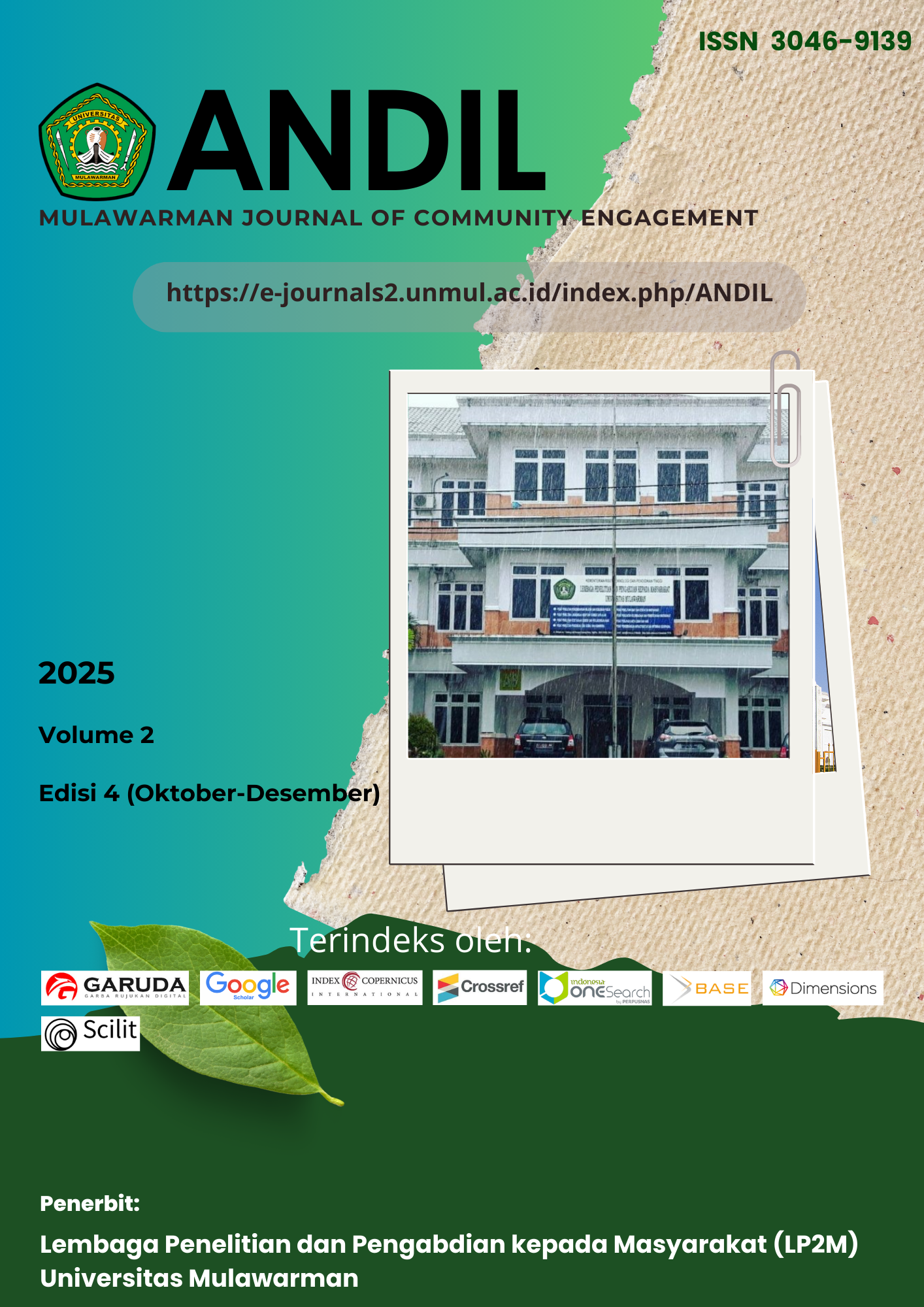Capacity Building for Fish Farmers in Linggang Tering Seberang Village in Independent Fish Feed Production and Fish Disease Control
Peningkatan Kapasitas Petani Budidaya Ikan di Kampung Linggang Tering Seberang dalam Pembuatan Pakan Ikan Mandiri dan Pengendalian Penyakit Ikan
DOI:
https://doi.org/10.30872/v2i4.142149Keywords:
Potential, Pokdakan, Probiotics, Nutrition, AnimalAbstract
Kampung Linggang Tering Seberang has significant aquaculture potential and plays an important role in providing nutrition from fish, especially in the Tering District. Constraints related to fish feed and diseases have caused this business to not develop well. Improving understanding related to fish farming activities, especially the independent provision of fish feed and disease control, is important so that interest in fish farming continues to grow. This training was conducted at the Village Hall of Kampung Lenggang Tering Seberang, with a total of 20 participants from the Pokdakan in the vicinity of Kampung Lenggang Tering Seberang. The training activities are conducted with the delivery of theory and practice. The training results show that the interest of fish farmers has increased in understanding the process of making fish feed with simple formulations and the production of fish probiotics. This is evident from the enthusiasm of the fish farmers during the Q&A session and the high level of engagement in the practical activities. The participants' understanding of the function of fish feed increased from 15% to 85%, while the understanding of the function of feed for growth increased from 45% to 75%, for disease prevention from 45% to 65%, and for fish health from 10% to 50%. The participants' understanding of the good feed content, which should include protein, fat, and carbohydrates, increased from 30% to 75%. Meanwhile, the participants' response before the training regarding the selection of feed raw materials showed that 60% chose bran flour, but after the training, the participants' response shifted to fish meal with a percentage reaching 75%.
References
Agustin, B. A., Puspawaty, N., & Rukmana, R. M. (2018). Aktivitas Antibakteri Kombinasi Ekstrak Etanolik Daun Beluntas (Pluchaea indica Less.) dan Meniran (Phyllanthus niruri L.) terhadap Bakteri Staphylococcus aureus. Biomedika, 12(02), 79–97.
Agustina, A., Saptiani, G., & Hardi, E. H. (2022). Isolation and identification of potential lactic acid bacteria as probiotics from the intestines of repang fish (Puntioplites waandersi). AACL Bioflux, 15(1), 24–33.
Andriani, Y., & Pratama, R. I. (2023). Pelatihan Pembuatan Pakan Buatan untuk Budidaya Ikan Nila Salin di Desa Wanantara, Kecamatan Sindang, Kabupaten Indramayu. Midang: Jurnal Pengabdian Kepada Masyarakat, 1(1), 19–22.
Gunawan, R. G. . (2015). Membuat Sendiri Pakan Ikan Murah dan Praktis. Jakarta: AgroMedia.
Marlida, R. (2020). Bioflok sebagai Solusi Mengatasi Permasalahan Lingkungan untuk Akuakultur Masa Depan Berkelanjutan : Sebuah Tinjauan. Rawa Sains : Jurnal Sains Stiper Amuntai, 10(1), 38–44. https://doi.org/10.36589/rs.v10i1.116 on African
Mulia, D. S., Utomo, T., & Isnansetyo, A. (2022). The efficacy of Aeromonas hydrophila GPl-04 feed-based vaccine catfish (Clarias gariepinus). Biodiversitas, 23(3), 1505–1510. https://doi.org/10.13057/biodiv/d230339
Rumondang, Ningsih, D. A., Sari, I., & Sari, P. (2016). Penyakit Pada Ikan. Yogyakarta: Eureka Media Aksara.
Sary, I. R. (2019). Penyediaan Pakan Ikan Air Tawar. Jakarta: Direktorat Jendral Guru dan Tenaga Kependidikan Kementrian Pendidikan dan Kebudayaan.
Setyono, B. D. H., Marzuki, M., Scabra, A. R., & Sudirman. (2020). Efektivitas Tepung Ikan Lokal dalam Penyusunan Ransum Pakan Ikan Nila (Oreochromis niloticus). Jurnal Perikanan, 10(2), 183–194. Retrieved from https://doi.org/10.29303/jp.v10i2.214
Sunarno, M. T. D., Kusmini, I. I., & Prakoso, V. A. (2017). Pemanfaatan bahan baku lokal dı klungkung, balı untuk pakan ıkan nıla best (Oreochromis niloticus). Media Akuakultur, 12(2), 105–112. https://doi.org/10.15578/ma.12.2.2017.105-112
Downloads
Published
Issue
Section
License
Copyright (c) 2025 Adi Susanto, Agustina Agustina, Muhammad Auzan Anshorullah, Andi Astri, Riska Amalia Putri, Theresi Reselyn Amabilis Sart, Aninda Dewi Meiliasari, Sinta Ariani, Andre Kurniawan, Anditia Agusmanto, Davina Mutiara Adi, Andini Fadhila, Djaman Fredereik Julian Antoni

This work is licensed under a Creative Commons Attribution 4.0 International License.













